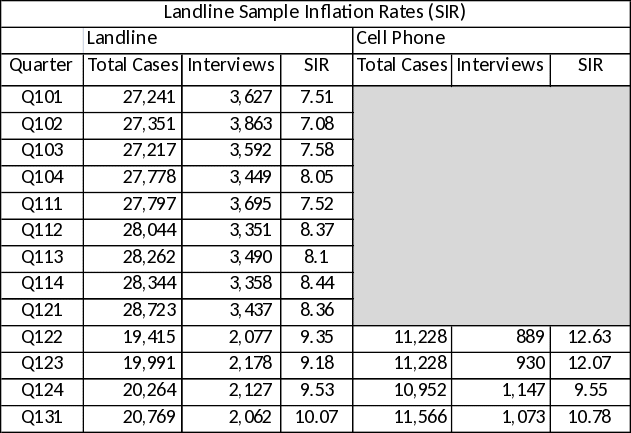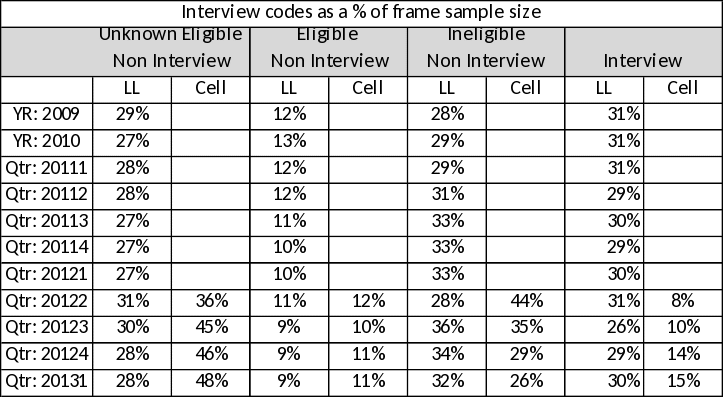Supporting_Statement_Part_B_2014-2016
Supporting_Statement_Part_B_2014-2016.docx
Telephone Point of Purchase Survey
OMB: 1220-0044
SUPPORTING STATEMENT
B. Collections of Information Employing Statistical Methods
1. Sample Selection and Universe
The universe of TPOPS is the civilian non-institutional urban population of the U.S.
The sample design for TPOPS is a two-phase sample where the BLS selects a sample of PSUs in the first phase and the Census Bureau selects a sample of telephone numbers within the PSUs in the second phase. For TPOPS a PSU is a county or group of counties. The second phase sample is a random digit dialing (RDD) sample of land-line and cell phone numbers.
The BLS expects a total number of 14,320 completed interviews for each quarter, distributed over approximately 87 sample PSUs. (Note: Each respondent is in for 4 quarters. To maintain 14,320 completed interviews each quarter, approximately 26,653 cases (15,087 landline numbers and 11,566 cell phone numbers) are added each quarter as old respondents drop out. The PSUs in TPOPS are of three types: (1) large self-representing (SR) Metropolitan Statistical Areas (MSAs), (2) medium and small non-self-representing (NSR) MSAs and (3) NSR urban, non-metropolitan areas in sample.
Currently, within each PSU the Census Bureau selects two different samples from two different frames. One sample is selected from a landline frame. The landline frame is a list-assisted RDD sample of telephone numbers. It is called listed-assisted because the within PSU sampling frame includes all of the land-line telephone numbers in working banks with at least one telephone number listed in the white pages. Here a working bank is defined as the set 100 telephone numbers with the same first eight digits. Working banks are historically the unit which telephone companies use to manage telephone numbers. For each PSU, sampling will be carried out independently using the GENSYS software. Once the GENESYS sampling frame is subset into the appropriate PSUs, an equal probability of selection method (EPSEM) RDD sample of land-line telephone numbers for each PSU is selected independently using the GENESYS software. An EPSEM RDD sample is a single stage equal probability selection of sample telephone numbers.
To support cell phone collection, a second sample is selected from the cellular frame. The cellular frame is also a RDD sample of telephone numbers from a database constructed by incorporating wire center data. A wire center is typically a general geographic area which is serviced by a defined set of exchanges. Each wire center has a set of area code exchanges (NPA-NXX) with the same first six digits that are dedicated to providing wireless service. It is not list assisted. There are no published or compiled lists of cellular telephone numbers available. The sample generation for the cellular frame is also an EPSEM sample where every possible number has an equal probability of selection.
In practice, the type of phone service will be identified at the beginning of the first interview with a respondent. Starting with the second quarter of 2012, cell phone respondents who have moved out of the area for which they were selected are eligible if their new residence is within the boundaries of another CPI PSU.
Data from the National Health Interview Survey (NHIS) were used to estimate the percentages of (i) cell-only, (ii) landline only, and (iii) both cell and landline households. The target number of interviewed cases required in TPOPS, in each PSU, was split into the two frames based upon these percentages. Households that fall into the ‘Both’ landline and cell phone category were divided between the two frames based on results from the NHIS for July-December, 2008. The NHIS survey asked households that had at least one landline and at least one cell phone what phone they mostly used: 24% in urban areas considered themselves to be cell-mostly. Using these data, 25% of the target for ‘Both’ will go into the cell phone frame and 75% into the landline frame.
Once the two samples have been selected and interviewed, we combine them together using a composite estimator. Composite estimators combine the two samples in a way that properly reflects probabilities of selection and will allow us to adjust for dual user populations. The dual users in the survey are identified using new questions regarding the number of landline and cell phone numbers used in the household.
Results from the TPOPS cell phone test conducted in the first quarter of 2011 showed the number of calls needed to get one completed cell phone interview. Including the test results and four quarters of recent TPOPS collection results of sample inflation rates, the number of telephone numbers selected for the first interview has increased.1 Approximately 8.6 telephone numbers are selected to get one completed interview in the first quarter of interviewing for landlines, and approximately 9.6 numbers are selected for cell phones.

The reasons for not completing an interview include non-interviews and ineligible units. The three types of ineligible units for an RDD survey include nonresidential units, nonworking numbers, and units not within the PSU boundaries.

Historically in the single landline frame sample the rate of non interviews has been relatively stable and evenly split between ineligible or unknown eligible cases. During the last few years there has been a slight increase in the percentage of ineligible cases for landline, mostly identified as ‘Non working’ phone numbers. Since the introduction of the cell phone frame we have observed a high rate of unknown eligible cases identified as phone numbers where no message could be left, was not in service, or there was no response to messages left.
2. Survey Design
Data Collection
The design of the 2014-2016 TPOPS survey consists of the collection of the point-of-purchase information from roughly 76,111 households. The U.S. Bureau of the Census, acting as an agent for the U.S. Bureau of Labor Statistics, is responsible for the collection in all phases of the survey.
Percentage of eligible units that participated in TPOPS |
|
Quarter |
Percentage |
Q103 |
56% |
Q104 |
57% |
Q111 |
58% |
Q112 |
55% |
Q113 |
56% |
Q114 |
55% |
Q121 |
56% |
Q122 |
48% |
Q123 |
43% |
Q124 |
46% |
Q131 |
45% |
Of the sample of telephone numbers, approximately 60 percent will be known eligible residential households. Of these, approximately 45 percent of the units will participate in the survey. While this interview rate seems low, it is consistent with response rates achieved in random digit dial surveys throughout the survey industry. These response rates vary by PSU and the total designated sample by PSU is adjusted accordingly.
In the survey, one respondent will be interviewed for all members of one household in the sample household. A household is defined as a person living alone or a group of two or more persons who are related by blood, marriage, or other arrangement, or a group of two or more persons who share major expenses. An early question will identify the household member who “has knowledge of the household expenditures” (18 years of age or older). It is expected that in many cases this person will be the one who answers the phone.
Each household may be contacted for an interview four times (once per calendar quarter) over a period of 1 year. Exceptions to this include those households identified as ineligible during their first interview and those households who refuse to participate in the survey in two consecutive quarters. The Census Bureau also does not call numbers identified as nonworking during their first interview.
The categories of goods and services for which TPOPS collects outlets are divided into 16 groups with each group comprising 12-16 categories. During a quarter, one of the 16 groups is asked in each PSU such that in any one PSU, over a 4 year period, all categories will be asked. It is also the case that in any given quarter, every category will be asked in at least one PSU.
Quality Control
In this survey, the Census Bureau will maintain high levels of data accuracy and response rates through interviewer instruction, training, and close monitoring of the data. At the CATI facilities, staff will have the ability to monitor interviewers at any time and provide immediate verbal feedback.
Methods to Maximize Response.
RDD Telephone Surveys are expected to have high non-response rates. In the implementation of TPOPS, the following procedures are used to maximize response rates and reduce nonresponse:
A private company, M-S-G, screens out business numbers and other ineligible telephone numbers from the selected sample.
Advance letters are sent to all sample telephone numbers that can be associated with an address. To get the addresses, the samples of telephone numbers are provided to the private company Telematch. They then match the telephone numbers to their files and return the associated addresses.
Addresses are collected in the first contact with a respondent. Letters or postcards are sent to households prior to each subsequent quarter for which they are in sample.
Starting in early 2014 follow up letters will be sent during the interviewing period to soft refusals.
Floor Supervisors in each CATI facility who specialize in converting refusals.
A respondent website is available containing background information about the survey, and a schedule of what types of questions will be asked each quarter in each eligible county.
CPI conducted a non-response bias analysis in 2009 to attempt to determine if the TPOPS exhibits non-response bias. The goal of the TPOPS is to collect a representative frame of outlets from which to select the outlet sample for the CPI’s pricing survey. Because there is no good source to determine how representative the outlets from TPOPS are, two proxies were used: demographics and expenditures. This analysis has been updated in 2012. The analysis was updated using the data collected during the introduction of the TPOPS dual frame, see Attachment F “An Updated Nonresponse Bias Analysis of the Telephone Point of Purchase Survey.” The paper highlights the improved demographic coverage since the addition of the cell phone frame, but due to the short time period there were insufficient data to determine outlet bias. A reexamination using more data will be conducted in 2014.
Testing of Procedures.
The BLS acceptance tests all CATI instruments before their implementation in the field. For each quarter that new sample is being introduced, BLS will review the instrument to ensure that the correct PSUs will be contacted. Any instrument changes are tested with mock scenarios to ensure the correct path is followed in a variety of circumstances. Additionally, cognitive testing is used for any questionnaire changes before implementation.
5. Statistical Contact
The BLS has consulted the following
individual:
Stephen Ash
Statistical Methods Division, Bureau of the Census
(301) 763-4294
1 Sample inflation estimates for the landline are calculated on the frame before screening done by the Marketing Systems Group (MSG). In early 2013 a new rule to screen numbers on the “Do Not Call” (DNC) list was added.
| File Type | application/vnd.openxmlformats-officedocument.wordprocessingml.document |
| Author | Wirth_C |
| File Modified | 0000-00-00 |
| File Created | 2021-01-22 |
© 2026 OMB.report | Privacy Policy